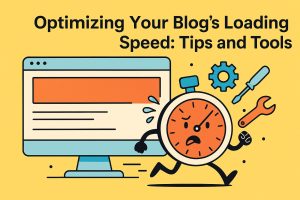Affiliate Marketing for Bloggers: A Comprehensive Guide
Affiliate marketing is a powerful strategy for bloggers to monetize their content and generate revenue. By promoting products or services through affiliate links, bloggers can earn commissions on sales made through their referrals. This comprehensive guide will walk you through the essential steps and best practices for successful affiliate marketing.
1. Understanding Affiliate Marketing
- Definition: Affiliate marketing involves promoting products or services through unique affiliate links. When your audience makes a purchase via your link, you earn a commission.
- Components: The main players in affiliate marketing are the merchant (product/service provider), the affiliate (you), and the customer (your audience).
How It Works:
- Sign Up: Join an affiliate program or network.
- Promote: Integrate affiliate links into your blog content.
- Earn: Receive commissions for sales generated through your links.
2. Choosing the Right Affiliate Programs
Selecting suitable affiliate programs is crucial for ensuring alignment with your blog’s niche and audience.
Criteria for Selection:
- Relevance: Choose programs that align with your blog’s topic and resonate with your audience’s interests. For instance, if your blog focuses on education or skill development, you could promote platforms and tools related to how to sell online courses.
- Reputation: Partner with reputable companies with a track record of reliable products and timely payments.
- Commission Structure: Evaluate the commission rates and payment terms to ensure they meet your financial goals.
- Support and Resources: Opt for programs that offer marketing materials, support, and tracking tools.
Popular Affiliate Networks:
- Amazon Associates: Offers a wide range of products across various categories.
- ShareASale: Provides access to numerous merchants and diverse products.
- CJ Affiliate (formerly Commission Junction): Features a broad network of top brands.
3. Integrating Affiliate Links into Your Blog
Effective integration of affiliate links can enhance user experience and increase conversion rates.
Best Practices:
- Natural Placement: Embed affiliate links within relevant content, such as product reviews, comparisons, or tutorials.
- Disclosure: Clearly disclose affiliate links to maintain transparency and build trust with your audience.
- Call-to-Action (CTA): Use compelling CTAs to encourage readers to click on affiliate links.
Example Techniques:
- Product Reviews: Write in-depth reviews of products with embedded affiliate links.
- How-To Guides: Include links to products or services used in your tutorials.
- Comparison Posts: Compare similar products with affiliate links to each option.
4. Creating High-Quality Content for Affiliate Marketing
High-quality content attracts readers and encourages them to click on affiliate links.
Content Strategies:
- Value-Driven Posts: Provide useful information, tips, or solutions that align with your audience’s needs. In addition to affiliate marketing, consider incorporating sponsored posts best practices to diversify your income streams and maintain quality content.
- Engaging Formats: Use various content formats such as articles, videos, infographics, and lists to maintain reader interest.
- SEO Optimization: Optimize content for search engines to attract organic traffic and increase the likelihood of conversions.
Content Ideas:
- Listicles: Curate lists of recommended products or services.
- Tutorials: Create step-by-step guides that incorporate affiliate products.
- Case Studies: Share real-life examples and experiences related to the products you promote.
5. Tracking and Analyzing Performance
Monitoring the performance of your affiliate marketing efforts helps you understand what works and where to improve.
Metrics to Track:
- Click-Through Rate (CTR): Measure the percentage of readers who click on your affiliate links.
- Conversion Rate: Track the percentage of clicks that result in sales.
- Earnings Per Click (EPC): Calculate the average earnings per click to evaluate the profitability of your links.
- Return on Investment (ROI): Assess the overall effectiveness of your affiliate marketing strategy.
Tools and Platforms:
- Affiliate Dashboards: Use the reporting tools provided by affiliate programs to monitor performance.
- Google Analytics: Track traffic sources, user behavior, and conversion metrics on your blog.
6. Building Trust with Your Audience
Establishing and maintaining trust is essential for successful affiliate marketing.
Strategies:
- Authenticity: Promote products and services that you genuinely believe in and have used.
- Transparency: Be open about your affiliate relationships and clearly disclose affiliate links.
- Engagement: Foster a strong relationship with your audience through interactive content and responsive communication.
7. Staying Updated with Trends and Best Practices
The affiliate marketing landscape is constantly evolving, so staying informed about industry trends and best practices is crucial.
Ways to Stay Updated:
- Subscribe to Industry News: Follow blogs, newsletters, and forums related to affiliate marketing.
- Attend Webinars and Conferences: Participate in industry events to learn about new strategies and tools.
- Network with Other Affiliates: Join affiliate marketing communities to share insights and experiences.
Conclusion
Affiliate marketing offers a lucrative opportunity for bloggers to generate income while providing value to their audience. By choosing the right affiliate programs, integrating links effectively, creating high-quality content, and tracking performance, you can maximize your earnings and build a successful affiliate marketing strategy.














Post Comment